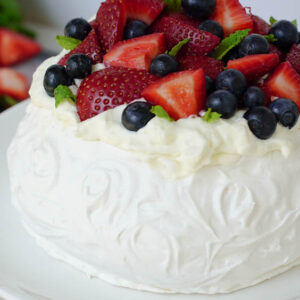
Classic New Zealand Pavlova
Pavlova boasts a crisp meringue shell and a soft, marshmallow-like center, topped with luscious whipped cream and fresh fruits.
Equipment
- digital scale
- electric mixer
- measuring spoons tsp/tbsp
- soft rubber spatula
- sheet pan
- oven thermometer
Ingredients
- 3 egg whites room temp
- 150 g caster sugar
- 1 tsp vinegar
- 2 tsp corn starch
- ½ tsp vanilla extract
Instructions
- Preheat oven to 275F. Having the pavlova enter the oven at a higher temperature will help the crust to set and create the structure for the pavlova.
- Wipe down the metal/glass bowl with a few drops of vinegar or lemon juice. This will help wipe off any grease that may be lingering on the bowl.
- Separate 3 egg whites. Make sure eggs are room temp as they’re easier to whip and gain more volume. Start whipping on a low-medium speed (4 on a kitchen aid) until your eggs are broken up and begin to foam; once you reach a soft peak stage, you can increase the mixer one level (6 on a kitchen aid)
- Begin adding the caster sugar (or grinded granulated sugar) one tablespoon at a time every 30-45 seconds. This should take a total of 10 minutes, Make sure you scrape down the sides of the bowl until all caster sugar is dissolved. Your peaks should be becoming stiffer by this point.
- Bring back down to a low-medium speed (4 on a kitchen aid) and add the vinegar, cornstarch, and vanilla. Keep mixing on level 4 for another 5 minutes.
- Your meringue should have reached stiff peaks. You should be able to comfortably turn your mixing bowl upside down with your meringue inside it - it should remain stable in the bowl and not fall out.
- Scoop or pipe your meringue inside the traced 6-inch circle. Pile your pavlova to be around 10-15cm tall. Then create a small/medium smooth crater on the top of your pavlova, this will be a nest that can hold the cream and fruit you top your pavlova with.
- Bring the oven temperature down to 200F and place your Pavola inside to bake for 1 hour and 10 minutes.
- Once the pavlova has baked for an hour and 10 minutes, keep the oven door closed and leave the pavlova inside the oven for 1 1/2 hours minimum. You can also keep the pavlova inside the oven overnight.
Tried this recipe? Tag us @Gooddaytobake on instagramLet us know how it was!